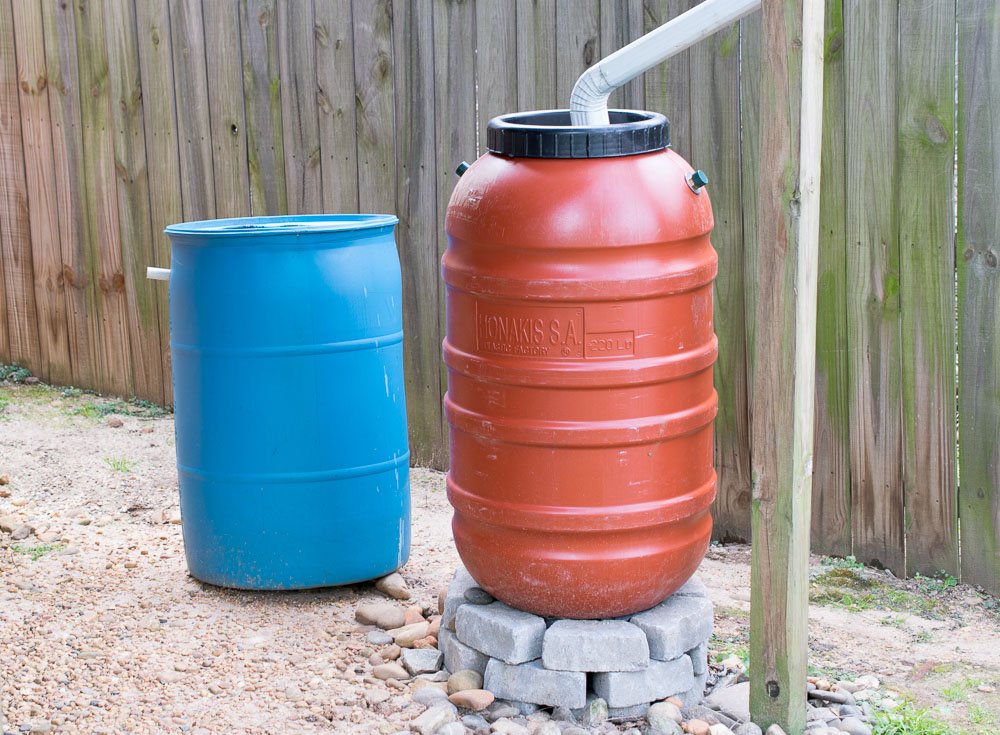5 Urban Garden Rain Barrel Features Yours Must Have
We didn't even use our garden hose last summer. Instead, we use our urban garden rain barrel to save gallons of non-chlorinated garden water every time it rains. Between the rain barrel and the garden ollas, our plants thrived in Virginia's summer heat. Yours can too.
Rain barrel basics
There are five key features to look for when choosing a rain barrel. We learned this the hard way, by starting with a salvaged rain barrel with substandard features, and then upgrading to a better one. A bad rain barrel is better than none, but if you're starting from scratch you can choose wisely.
We aren't evaluating rain barrel size because most seem to come in roughly 90-gallon capacity. Any more would be too small to bother with, and larger ones wouldn't be very portable. Anything bigger than about 100 gallons would be more of a cistern - a permanent installation.
These are the key features to evaluate for an urban garden rain barrel:
Material
Rain barrels come in wood or plastic. Wooden barrels, which are usually repurposed whisky or wine barrels, are very attractive and environmentally friendly. That was our first choice but when we started asking barrel owners we learned that wood is a lot more expensive, heavy, hard to find, rots quickly and tends to leak.
We don't love plastic, but in this case it seemed like a better choice. It's lightweight and easy to move, ages well and is easy to source. It's also a lot cheaper, and you can often get replacements parts (like lids or screens). Plastic comes in various colors, and we found a wood-ish brown we could live with.
Lid
Make sure the screen is securely fastened in your garden rain barrel lid.
The barrel should have a lid! Seems obvious, but our first one didn't, and a lot of leaves and other debris fell in. The lid should be removable, of course, and ideally large enough to dip in a bucket or watering can.
Extra points for a lid that's replaceable. Check to see if you can order an extra down the road, in case yours breaks.
Screen
A garden rain barrel with no lid makes a terrific mosquito nursery.
Not only did our lidless rain barrel collect a lot of debris, but the mosquitoes loved it. We ran the healthiest mosquito nursery in the neighborhood! The floating mosquito discs didn't seem to do a thing.
Make sure your rain barrel lid has a fine mesh screen so mosquitoes can't lay eggs. Make sure it's fastened well enough to stand up to water pressure and some leaf accumulation. And make sure you can replace it if (when) it rips.
Valve
A brass spigot will last longer than plastic.
Brass is sturdier and longer lasting than plastic. Check to make sure the handle operates smoothly, and that the spigot end is threaded for connecting a hose.
Our updated rain barrel has a brass spigot, but it fails in one key regard: The spigot is really close to the barrel, which makes it tough to slip a watering can underneath. Look instead for one more like our plastic valve, which sticks out a little further from the barrel.
Overflow
Once you have one rain barrel, and you see all the wasted overflow water during a rainstorm, you may want to add another. Or another. Most plastic barrels have overflow valves at the top so you can connect extra barrels with a hose.
Look for overflow valves that are threaded for hose connections. It's handy to have one overflow valve on each side of the barrel, so you can position the overflow barrel on either side. Also, make sure the overflow valves have caps so nothing can creep inside.
Rain barrel installation tips
When you have your perfect barrel, spend a little time on installation to make it easier to use. Install the barrel raised, so you have room to put a watering can under the spigot. Extra height also creates more water pressure. We built our rain barrel support base from fire pit stones placed in a tight circle, and filled the base with sand to support the bottom of the barrel.
Build a sturdy rain barrel base so gravity can create good water pressure.
Reroute your downspout if necessary. Get the rain barrel exactly where you want it, because once it's installed and filled, it's not going anywhere.
If you can't find a barrel with the perfect features, don't worry. A substandard rain barrel is better than none! Our basic barrel was free, so the price was right, and we used it for two years before upgrading. Get one this season and watch your water bill shrink.




